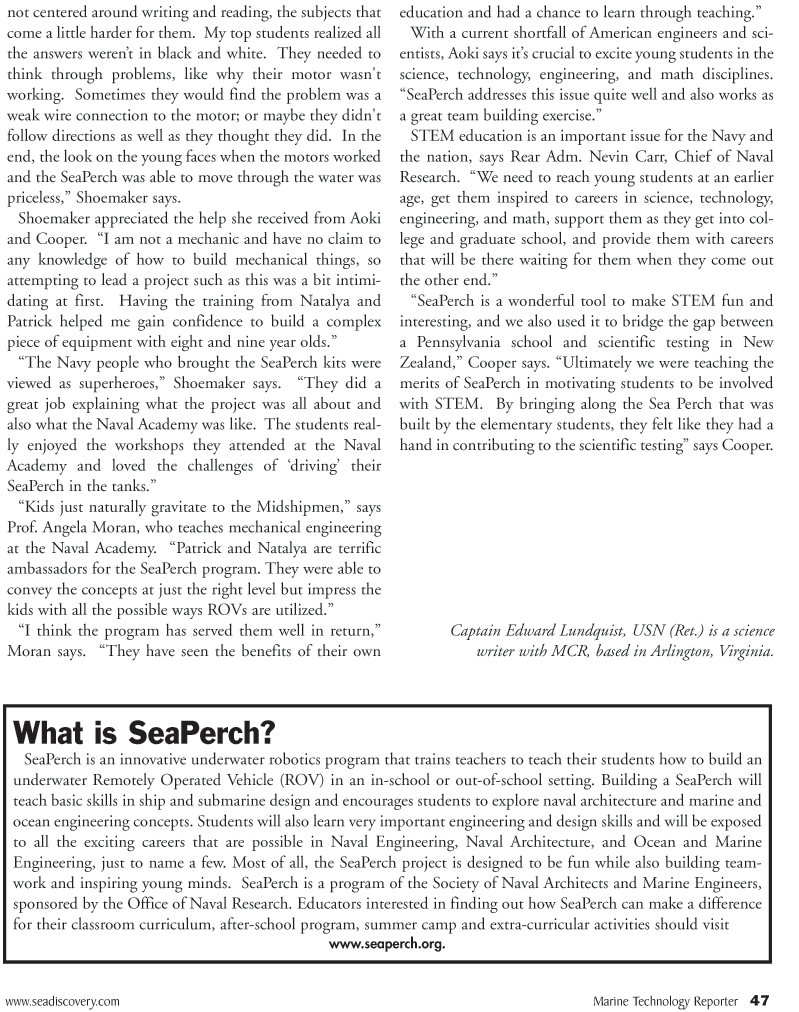
Page 47: of Marine Technology Magazine (January 2011)
Marine Salvage & Recovery
Read this page in Pdf, Flash or Html5 edition of January 2011 Marine Technology Magazine
www.seadiscovery.com Marine Technology Reporter 47 not centered around writing and reading, the subjects that come a little harder for them. My top students realized all the answers weren’t in black and white. They needed to think through problems, like why their motor wasn't working. Sometimes they would find the problem was a weak wire connection to the motor; or maybe they didn't follow directions as well as they thought they did. In the end, the look on the young faces when the motors worked and the SeaPerch was able to move through the water was priceless,” Shoemaker says.
Shoemaker appreciated the help she received from Aoki and Cooper. “I am not a mechanic and have no claim to any knowledge of how to build mechanical things, so attempting to lead a project such as this was a bit intimi- dating at first. Having the training from Natalya and
Patrick helped me gain confidence to build a complex piece of equipment with eight and nine year olds.” “The Navy people who brought the SeaPerch kits were viewed as superheroes,” Shoemaker says. “They did a great job explaining what the project was all about and also what the Naval Academy was like. The students real- ly enjoyed the workshops they attended at the Naval
Academy and loved the challenges of ‘driving’ their
SeaPerch in the tanks.” “Kids just naturally gravitate to the Midshipmen,” says
Prof. Angela Moran, who teaches mechanical engineering at the Naval Academy. “Patrick and Natalya are terrific ambassadors for the SeaPerch program. They were able to convey the concepts at just the right level but impress the kids with all the possible ways ROVs are utilized.” “I think the program has served them well in return,”
Moran says. “They have seen the benefits of their own education and had a chance to learn through teaching.”
With a current shortfall of American engineers and sci- entists, Aoki says it’s crucial to excite young students in the science, technology, engineering, and math disciplines. “SeaPerch addresses this issue quite well and also works as a great team building exercise.”
STEM education is an important issue for the Navy and the nation, says Rear Adm. Nevin Carr, Chief of Naval
Research. “We need to reach young students at an earlier age, get them inspired to careers in science, technology, engineering, and math, support them as they get into col- lege and graduate school, and provide them with careers that will be there waiting for them when they come out the other end.” “SeaPerch is a wonderful tool to make STEM fun and interesting, and we also used it to bridge the gap between a Pennsylvania school and scientific testing in New
Zealand,” Cooper says. “Ultimately we were teaching the merits of SeaPerch in motivating students to be involved with STEM. By bringing along the Sea Perch that was built by the elementary students, they felt like they had a hand in contributing to the scientific testing” says Cooper.
Captain Edward Lundquist, USN (Ret.) is a science writer with MCR, based in Arlington, Virginia.
What is SeaPerch?
SeaPerch is an innovative underwater robotics program that trains teachers to teach their students how to build an underwater Remotely Operated Vehicle (ROV) in an in-school or out-of-school setting. Building a SeaPerch will teach basic skills in ship and submarine design and encourages students to explore naval architecture and marine and ocean engineering concepts. Students will also learn very important engineering and design skills and will be exposed to all the exciting careers that are possible in Naval Engineering, Naval Architecture, and Ocean and Marine
Engineering, just to name a few. Most of all, the SeaPerch project is designed to be fun while also building team- work and inspiring young minds. SeaPerch is a program of the Society of Naval Architects and Marine Engineers, sponsored by the Office of Naval Research. Educators interested in finding out how SeaPerch can make a difference for their classroom curriculum, after-school program, summer camp and extra-curricular activities should visit www.seaperch.org.

 46
46

 48
48
